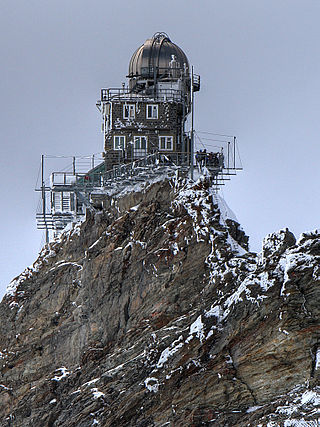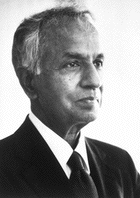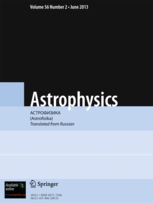
An observatory is a location used for observing terrestrial, marine, or celestial events. Astronomy, climatology/meteorology, geophysics, oceanography and volcanology are examples of disciplines for which observatories have been constructed. Historically, observatories were as simple as containing an astronomical sextant or Stonehenge.

Subrahmanyan Chandrasekhar was an Indian-American theoretical physicist who spent his professional life in the United States. He shared the 1983 Nobel Prize for Physics with William A. Fowler for "...theoretical studies of the physical processes of importance to the structure and evolution of the stars". His mathematical treatment of stellar evolution yielded many of the current theoretical models of the later evolutionary stages of massive stars and black holes. Many concepts, institutions, and inventions, including the Chandrasekhar limit and the Chandra X-Ray Observatory, are named after him.
The Astrophysical Journal (ApJ) is a peer-reviewed scientific journal of astrophysics and astronomy, established in 1895 by American astronomers George Ellery Hale and James Edward Keeler. The journal discontinued its print edition and became an electronic-only journal in 2015.

The American Astronomical Society is an American society of professional astronomers and other interested individuals, headquartered in Washington, DC. The primary objective of the AAS is to promote the advancement of astronomy and closely related branches of science, while the secondary purpose includes enhancing astronomy education and providing a political voice for its members through lobbying and grassroots activities. Its current mission is to enhance and share humanity's scientific understanding of the universe as a diverse and inclusive astronomical community.
Astrophysics is a science that employs the methods and principles of physics and chemistry in the study of astronomical objects and phenomena. As one of the founders of the discipline, James Keeler, said, Astrophysics "seeks to ascertain the nature of the heavenly bodies, rather than their positions or motions in space–what they are, rather than where they are." Among the subjects studied are the Sun, other stars, galaxies, extrasolar planets, the interstellar medium and the cosmic microwave background. Emissions from these objects are examined across all parts of the electromagnetic spectrum, and the properties examined include luminosity, density, temperature, and chemical composition. Because astrophysics is a very broad subject, astrophysicists apply concepts and methods from many disciplines of physics, including classical mechanics, electromagnetism, statistical mechanics, thermodynamics, quantum mechanics, relativity, nuclear and particle physics, and atomic and molecular physics.

Gustav Wilhelm Ludwig von Struve was a Baltic German astronomer, part of the famous Baltic German Struve family. In Russian, his name is sometimes given as Lyudvig Ottovich Struve or Lyudvig Ottonovich Struve.

Monthly Notices of the Royal Astronomical Society (MNRAS) is a peer-reviewed scientific journal covering research in astronomy and astrophysics. It has been in continuous existence since 1827 and publishes letters and papers reporting original research in relevant fields. Despite the name, the journal is no longer monthly, nor does it carry the notices of the Royal Astronomical Society.

The Center for Astrophysics | Harvard & Smithsonian (CfA), previously known as the Harvard–Smithsonian Center for Astrophysics, is an astrophysics research institute jointly operated by the Harvard College Observatory and Smithsonian Astrophysical Observatory. Founded in 1973 and headquartered in Cambridge, Massachusetts, the CfA leads a broad program of research in astronomy, astrophysics, Earth and space sciences, as well as science education. The CfA either leads or participates in the development and operations of more than fifteen ground- and space-based astronomical research observatories across the electromagnetic spectrum, including the forthcoming Giant Magellan Telescope (GMT) and the Chandra X-ray Observatory, one of NASA's Great Observatories.

Bryan Malcolm Gaensler is an Australian astronomer based at the University of Toronto. He studies magnetars, supernova remnants, and magnetic fields. In 2014, he was appointed as Director of the Dunlap Institute for Astronomy & Astrophysics at the University of Toronto, after James R. Graham's departure. He is currently the co-chair of the Canadian 2020 Long Range Plan Committee with Pauline Barmby.
Vytautas Straižys was a Lithuanian astronomer. In 1963–65 he and his collaborators created and developed the Vilnius photometric system, a seven-color intermediate band system, optimized for photometric stellar classification. In 1996 he was elected a Corresponding Member of the Lithuanian Academy of Sciences. Straižys was an editor of the journal Baltic Astronomy. He spent a lot of time working at the Molėtai Astronomical Observatory. Asteroid 68730 Straizys in 2002 was named after him.

Alexander Dalgarno FRS was a British physicist who was a Phillips Professor of Astronomy at Harvard University.

Leibniz Institute for Astrophysics Potsdam (AIP) is a German research institute. It is the successor of the Berlin Observatory founded in 1700 and of the Astrophysical Observatory Potsdam (AOP) founded in 1874. The latter was the world's first observatory to emphasize explicitly the research area of astrophysics. The AIP was founded in 1992, in a re-structuring following the German reunification.

Astronomische Nachrichten, one of the first international journals in the field of astronomy, was established in 1821 by the German astronomer Heinrich Christian Schumacher. It claims to be the oldest astronomical journal in the world that is still being published. The publication today specializes in articles on solar physics, extragalactic astronomy, cosmology, geophysics, and instrumentation for these fields. All articles are subject to peer review.

Astronomy & Astrophysics is a monthly peer-reviewed scientific journal covering theoretical, observational, and instrumental astronomy and astrophysics. The journal is run by a board of directors representing 27 sponsoring countries plus a representative of the European Southern Observatory. The journal is published by EDP Sciences and the editor-in-chief is Thierry Forveille.

Astronomy Reports, is a Russian, monthly, peer reviewed, scientific journal. This journal tends to focus its publishing efforts on original research regarding astronomical topics. Other types of reporting are also included such as chronicles, proceedings of international conferences, and book reviews. Founded in 1924, it is described as the most prominent astronomy journal during the age of the Soviet Union. Originally a print version, it is also available online. The editor-in-chief was Alexander A. Boyarchuk, Institute of Astronomy of the Russian Academy of Sciences, Moscow, Russia.

The Journal of the Korean Astronomical Society is a bimonthly open access peer-reviewed scientific journal of astronomy published by the Korean Astronomical Society. It covers original work and review articles from all branches of astronomy and astrophysics. The journal was established in 1968 and the editor-in-chief is Sascha Trippe.
Publications of the Astronomical Society of Australia is a peer-reviewed scientific journal covering all aspects of astrophysics and astronomy. The editor-in-chief is Ivo Rolf Seitenzahl. It was established in 1967 and is published by Cambridge University Press on behalf of the Astronomical Society of Australia.

Astrophysics is a peer-reviewed scientific journal of astrophysics published by Springer. Each volume is published every three months. It was founded in 1965 by the Soviet Armenian astrophysicist Viktor Ambartsumian. It is the English version of the journal Astrofizika, published by the Armenian National Academy of Sciences mostly in Russian. The current editor-in-chief is Arthur Nikoghossian.
The Planetary Science Journal is a peer-reviewed open access scientific journal of astrophysics and astronomy, established in 2020. It is published by IOP Publishing on behalf of the American Astronomical Society. The founding editor-in-chief is Faith Vilas













